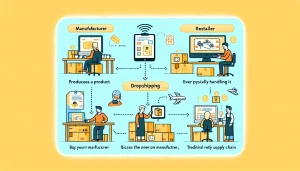Your dropshipping business may be your ticket to e-commerce glory or financial woe.
The world of dropshipping is like navigating a thrilling rollercoaster, full of exhilarating highs and staggering lows. Filled with potential for success, it also hides pitfalls that could spill doom for your business.
The pros and cons of dropshipping. Do the pros outweigh the cons? Let’s say, it’s complicated.
Every day, almost 33% of e-commerce stores employ the same dropshipping store” model. That translates to millions of businesses. To put this into perspective, it’s akin to the entire population of Canada opening online stores.
But, what shines isn’t always gold.
We’re going to clutch at the heart of the matter and disclose the pros and cons of a dropshipping business. Be prepared; this might just transform your venture into a powerhouse or remodel your entire perspective.
The Market Value of Dropshipping
The market value of dropshipping is expected to reach $243.42 billion in 2023, with an increase of 23.7% from 2022.

27% higher customer satisfaction
Professional delivery features:
- Real-time GPS tracking
- Automated ETA updates
- Delivery confirmation photos
- 27% higher delivery satisfaction
The Advantages of Dropshipping: Why It Could Be Your Game Changer
Low Startup Costs: Kickstart Your Business with Minimal Investment
A dropshipping business model presents any entrepreneur with an affordable gateway into the world of e-commerce. Unlike conventional retail, there’s no need to invest hefty sums in inventory.
Without the hurdle of substantial upfront costs and shipping costs, launching a new business or expanding an existing one becomes highly achievable. It’s akin to having your cake and eating it too; immerse yourself in the vast e-commerce space, but without draining your bank account.
Moreover, the low financial risk associated with the dropshipping model makes it a compelling option for those with limited capital. This cost-effectiveness is the lifeblood of countless successful businesses, and it could be your game-changer too.
No Inventory Hassles: Say Goodbye to Stock Management
Inventory management demands can be a major stumbling block for many businesses. Between storage costs, unsold stock depreciation, and the labor of managing stock – there’s plenty that could go wrong.
The beauty of dropshipping is that it absolves you from all these concerns. Your supplier maintains the inventory, saving you not only financial resources but also valuable time. This unlocked time could be channeled toward strategic initiatives like marketing, customer service, or business expansion.
Additionally, this model affords you flexibility. Your inventory is confined only by your suppliers’ stock and not by your financial ability to buy and store goods. This flexibility is yet another way that dropshipping can be a game-changer for your business.
Wide Product Selection: Offer More Without the Extra Costs
In a traditional business model, product selection often comes with significant expense. With dropshipping, an expansive product range is no longer a luxury reserved for businesses with large budgets.
Say, for instance, you’re launching a fitness equipment store. In the usual retail scenario, testing new products would involve considerable investment and risk. With dropshipping, you can simply add the product listing from your supplier’s catalog to your online store, without holding any physical stock.
That means no additional costs and the freedom to experiment with product offerings. It’s the simplicity that gives dropshipping its allure, elevating your business to new heights.
The Disadvantages of Dropshipping: The Challenges You Need to Overcome
Lower Profit Margins: The Trade-off for Convenience
Dropshipping’s convenience doesn’t always come free. One of the primary roadblocks is the potential for lower profit margins. Discover why this happens, and learn how to manage it effectively. Unlock the secrets to boosting your dropshipping success rate and ensure you’re part of the top 10%.
As you start your dropshipping venture, remember, you’re entrusting supply and shipping to a third party. While this convenience reduces overheads, it also cuts into your profits. You might find that the profit is modest compared to traditional retailing modes, where you buy wholesale and control your supply chain and inventory.
Dropshipping Business Profıt
Dropshipping is 10 to 20% more profitable than affiliate marketing.
Profit of Dropshippers
Dropshippers earn 20 to 30% of the profit from each sale.
Inventory Issues: Dealing with Out-of-Stock Dropshipping Suppliers
Imagine launching a killer marketing campaign, only to discover your supplier is out of stock a common dropshipping dilemma. Let’s dig into why this happens and how to handle it.
Dropshipping suppliers aren’t exclusively tied to you. They sell their products to numerous businesses, all competing for the same inventory. When an item goes out of stock, it quickly escalates into a client service headache. You’re left with backorders, disgruntled customers, and potential reputational damage. It also compromises your ability to forecast and manage inventory effectively.
Shipping Complexities: Navigating Multi-Supplier Shipping
With drop shipping, you might source products from different suppliers. Sounds good, right? Well, the downside is convoluted shipping processes that escalate customer costs. Let’s outline how you can anticipate and mitigate these problems.
Multiple suppliers often mean products are shipped from different locations, causing shipping rates to soar. Customers ordering multiple products might receive them in different packages, at different times, baffling and frustrating them. This lack of control over the shipping process can create a poor customer experience and increase returns and refunds.
Final Thoughts? While dropshipping has potential drawbacks, recognizing them upfront is key. The reward lies in overcoming challenges, and even huge online retailers like Amazon use drop shipping to their advantage. Now, what about those who’ve triumphantly navigated these choppy waters? Just wait!
Real-Life Dropshipping Success Stories: Proof That It Works
Success Story 1: Oberlo
1 in 4 online business owners struggle during the initial phase of their journey. Yet, Oberlo didn’t let the hurdles define his journey.
Starting with a humble investment, he launched an array of healthy snack choices online, and soon, his dropshipping venture was achieving monthly revenue figures most of us dream about.
His key to success? Building strong relationships with reliable suppliers who provided quality products and delivered top-notch service to his customers. His story underlines the importance of customer service, showcasing that putting the customers first can lead to unparalleled growth and success.
Success Story 2: AliDropship
Many businesses, yet, manage to thrive in dropshipping’s intense competition, as AliDropships story illustrates. AliDropship is a WordPress plugin and a standalone solution designed to streamline dropshipping from AliExpress.
Similar to Oberlo, AliDropship automates the process of importing products from AliExpress. The platform manages orders and makes it easier for entrepreneurs to run their dropshipping businesses. With AliDropship, users can import products, and customize product details. They can set pricing rules, and fulfill customer orders automatically.
Additionally, it offers features like built-in image editing, SEO optimization tools, and various payment gateway integrations. Overall, AliDropship aims to simplify the dropshipping process for WordPress users who want to leverage AliExpress as a supplier.
Success Story 3: SaleHoo
SaleHoo is an online wholesale directory and platform designed to connect individuals and businesses with trusted suppliers, wholesalers, manufacturers, and drop shippers from around the globe. With a comprehensive database of over 8,000 vetted suppliers across various industries and regions, SaleHoo simplifies the process of sourcing products for e-commerce businesses. Discover how SaleHoo ranks among the top Shopify dropshipping apps for 2024, making it easier for you to source products and expand your e-commerce venture.
Through its user-friendly interface, entrepreneurs can search for suppliers based on specific criteria such as product category, location, and minimum order requirements. SaleHoo’s rigorous supplier vetting process ensures that users have access to legitimate and reliable sources.
Additionally, SaleHoo provides valuable educational resources, including guides, tutorials, and community forums. Whether newcomers or seasoned entrepreneurs, users can benefit from SaleHoo’s support, assistance, and access to a community of like-minded individuals.
Overall, SaleHoo serves as a valuable resource for anyone looking to streamline their product sourcing process and build a successful online or e-commerce business.
These success stories of dropshipping stores emphasize the potential of dropshipping despite the challenges. Key success factors? Understanding target markets, selecting the right products, and providing superior customer service.
Overcoming Dropshipping Challenges: Tips from Successful Entrepreneurs
The road to a thriving dropshipping business is not without bumps. But fear not, these proven tactics employed by successful entrepreneurs can help you overcome hurdles.
Building Strong Supplier Relationships
The foundation of any successful dropshipping business lies in cultivating strong relationships with suppliers. Without trustworthy suppliers, meeting customer expectations becomes a herculean task.
Relationship-building with suppliers isn’t as difficult as it seems though. Transparency and open lines of communication are your secrets to success. Keep them informed of your business goals and challenges.
Supplier Communication Best Practices
Maintain regular communication with your suppliers. Regular check-ins allow you to discuss business objectives, address problems proactively, and exchange feedback. This simple practice fosters trust and mitigates any potential issues that could harm the business relationship. Furthermore, consider implementing a communication system to streamline this process, such as dedicated emails or chat platforms.
Implementing Effective Marketing Strategies
Effective marketing is the unsung hero of any business’s success. Your marketing strategy does more than just attract customers; it communicates your brand’s ethos and offerings.
But what makes a marketing strategy effective for a dropshipping business? The answer is twofold: understanding your target audience and leveraging the right digital marketing tactics.
Understanding Your Target Audience
Gaining a deep understanding of your target audience is half the battle in successful marketing. From demographics to purchasing habits – every piece of information is a clue that helps tailor your marketing messages.
Once you have a concrete idea of who you’re reaching out to, you can craft messages that resonate with their needs effectively. This boosts the likelihood of them choosing you over competitors.
Leveraging Digital Marketing Tactics
With a sound understanding of your audience, the next step is to employ digital marketing tactics. SEO, content marketing, and social media marketing – there are myriad ways to reach your audience. The key is to use channels that your audience frequents.
Dropshipping Popularity in eCommerce Platforms
More than 30% of eCommerce stores use dropshipping to fulfill orders.
Providing Excellent Customer Service
The final cornerstone of a successful dropshipping business is superb customer service. This facet cannot be overemphasized as it’s often the tie-breaker when customers are deciding between you and the competition.
Customer Service Best Practices
Rapid response times, a friendly demeanor, and taking responsibility for any shortcomings are hallmarks of good customer service. Customer complaints are not always easy to handle, but seeing them as opportunities for improvement and working actively to resolve them can be a game-changer.
Training your customer service representatives to treat each interaction as an opportunity to delight the customer can help you secure repeat business, and create a strong brand reputation.
Victory over the common dropshipping challenges isn’t a far-off dream. Armed with these tips from successful entrepreneurs, any hurdle can be surmounted with grace and alacrity.
Understanding the Dropshipping Business Model
What is Dropshipping?
Dropshipping offers a method for traditional retail businesses to sell products without having to stock or own inventory. Instead, they partner with a third-party supplier who fulfills the orders on their behalf. This makes dropshipping a low-cost, low-risk option for entrepreneurs, as it eliminates the need for a warehouse and reduces overheads. Discover what dropshipping entails and how it can transform your business model by delving into our comprehensive guide.
However, this convenience comes with its own set of challenges. Since the retailer or the entrepreneur does not have direct control over the inventory, issues like delivery complications, stock unavailability, or product quality control fall under the responsibility of third-party suppliers. Thus, establishing a good relationship and open line of communication with dropshipping suppliers is critical.
How Does Dropshipping Work?
Within the dropshipping business model, the process starts when a customer places an order for a product on the retailer’s online store. The retailer then forwards the customer’s order details to reliable dropshipping suppliers. The dropshipping supplier is responsible for packaging and shipping the product directly to the customer. For those wondering about what dropshipping entails and its operational mechanics, this comprehensive guide will answer all your questions about the dropshipping business model.
The most notable aspect of this model is that the retailer does not ever physically handle the products. They simply act as a “middleman” between the supplier and the customer. They make profits from the difference between the wholesale price (what they pay the supplier) and the retail price (what the customer pays them). Interested in exploring the benefits of dropshipping in bulk? Discover how it can streamline your business model and potentially increase your profit margins.
To succeed in this venture, retailers must ensure they choose products that are in demand, take inventory upfront, and forge strong supplier relationships to secure competitive wholesale pricing and ensure timely, efficient delivery. Learn how to pinpoint lucrative dropshipping niche markets and enhance your business by selecting the most in-demand products.
This understanding sets the foundation for evaluating the benefits and drawbacks of dropshipping that could have significant implications for your business’s future.
Dropshipping Sales
Around 27% of businesses have adopted dropshipping sales as their primary work model.
Is Dropshipping Right for You? Making the Decision
Assessing Your Business Goals and Resources
When considering dropshipping as a viable business model, an evaluation of your current business objectives is necessary. You may have a set goal of scaling your business quickly or reducing overhead costs. On the other hand, your agenda might be to expend minimum resources on inventory management. Discover the strategies for achieving your specific business objectives by developing a comprehensive plan for your dropshipping business with our step-by-step guide.
Dropshipping is an ideal model for swift business expansion. It has the potential to break the geographical barriers that may be impeding your growth. Apt for an online clothing store, a bookstore, or a hardware shop, the breadth and depth of products you can offer are limitless.
At the same time, remember that dropshipping significantly lowers storage and inventory-related costs. You save on the warehousing costs, and human capital expenses for inventory management, and take no risks related to unsold stock.
However, dropshipping can’t be a one-size-fits-all solution. It requires a reliable supplier network, a balance between quality and costs, and a customer service channel to handle shipping and delivery queries.
These considerations can help discern if dropshipping aligns with your business goals and the resources you are willing to invest.
Weighing the Pros and Cons
Despite its many compelling benefits, dropshipping isn’t without its constraints. There’s no skipping the hard truths if a balanced decision is the call of the day.
Profits in dropshipping are heavily reliant on volume, given the tight margins. Therefore, building a customer base and maintaining a steady flow of orders can be challenging yet crucial. Shipping errors, late deliveries, and item damages are other potential pitfalls that could impact your reputation.
However, by choosing reputable and reliable suppliers, many of these concerns can be mitigated. Plus, the minimized overhead costs, the wide range of products to sell, and the reduced risk of holding unsold inventory are attractive benefits of this business model.
In essence, it’s about striking a balance—aligning the perks of dropshipping with the tolerance for its possible pitfalls.
Taking the First Step: How to Get Started with Dropshipping
Embracing dropshipping begins with identifying the appropriate market niche and the right suppliers. They are ancillary to maintaining product quality and ensuring timely deliveries.
Next, evaluate the range and variety of products your chosen suppliers offer. It’s essential to market products that resonate with your target audience’s needs and preferences.
Lastly, partnering with an e-commerce platform that integrates well with your suppliers’ systems can help manage orders efficiently. Seek platforms reputed for robust performance, reliable customer service, and seamless e-commerce store integration capabilities.
This three-step approach can ensure a seamless launch into the arena of dropshipping.
By dissecting business goals, gauging the pros and cons of dropshipping, and understanding key steps in commencing a dropshipping business, you can make an informed decision that disruptively transforms your business.
Dropshipping Online Store
The dropshipping market is expected to hit $557.9 billion by 2025.
The Pros and Cons of Dropshipping: It’s Crunch Time
Dropshipping can truly revolutionize a business, offering flexibility and scalability. But remember, it also comes with its unique challenges, like supplier issues and shipping complexities.
The critical thing is you’re now equipped with this deep-end knowledge. It has the potential to massively shift how your business operates, whether it’s reducing overheads or gearing up for global reach.
It’s time for action. Assess your business model against the pros and cons we’ve discussed. Is dropshipping the right move for you? Take this knowledge, apply it, and observe the shifts. Trial and error is a huge part of understanding whether dropshipping is the right fit for your business.
What will the impact of dropshipping be on your business if you decide to take the plunge? Remember, this decision could very well reshape your business forever.
Let’s not just sit and ponder, let’s Dive into the Dropshipping Ocean!






























